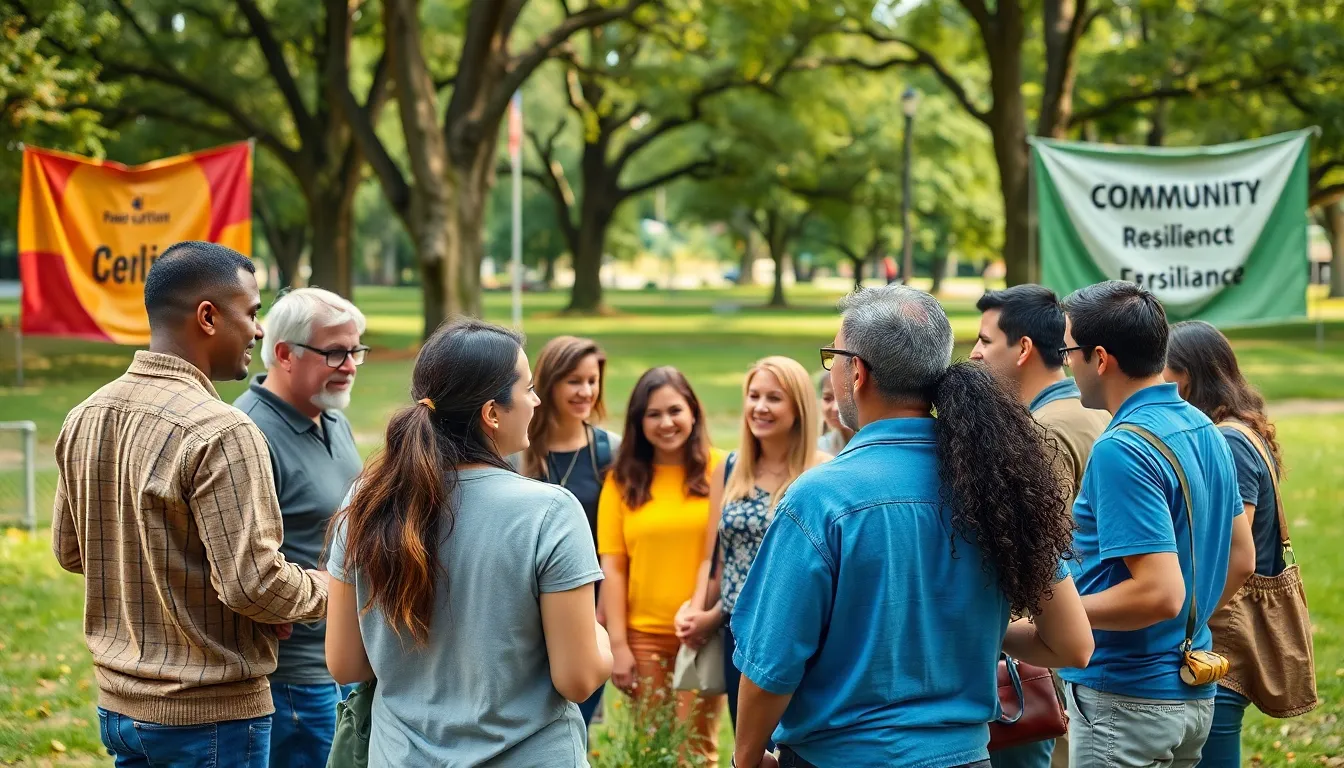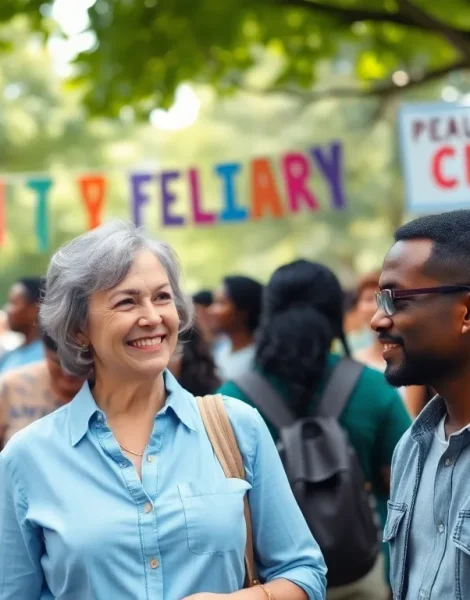In a world that seems to throw curveballs like a major league pitcher, understanding social resilience models is more important than ever. These frameworks help communities bounce back from adversity, whether it’s a natural disaster, economic downturn, or just a really bad hair day. Who knew that social science could be the superhero cape we all need?
By exploring how people connect, adapt, and thrive together, social resilience models reveal the secret sauce behind community strength. They show that when the going gets tough, the tough get social—and maybe share a few laughs along the way. So buckle up, because diving into these models not only equips individuals and communities to face challenges but also makes for a fascinating journey into the heart of human connection.
Table of Contents
ToggleOverview of Social Resilience Models
Social resilience models focus on the ability of communities to bounce back from adversities. These frameworks illustrate how social networks enable collective responses during crises. Factors such as trust, mutual support, and shared resources contribute significantly to resilience. Strong relationships within communities foster collaboration, leading to enhanced problem-solving capabilities.
Quantitative analyses show that communities with established social ties recover faster from natural disasters. For example, neighborhoods with active social groups experience a 30% shorter recovery time compared to those with weaker connections. Understanding these dynamics helps stakeholders design effective interventions that bolster community resilience.
Models encompass various dimensions, such as economic stability, social capital, and governance. Economic stability influences the resources available for recovery. Social capital enhances cooperation, while effective governance strengthens decision-making processes. Together, these dimensions create a comprehensive view of how resilience operates within societies.
Community engagement plays a pivotal role in implementing social resilience strategies. When individuals participate in planning and recovery efforts, they cultivate ownership and accountability. Research indicates that communities that engage their members in recovery initiatives report higher satisfaction and faster goal achievement.
Adapting resilience models to local contexts ensures their effectiveness. Tailoring approaches to meet specific community needs strengthens the relevance of interventions. Evaluating these models regularly keeps them aligned with evolving challenges and opportunities, promoting sustainable recovery efforts.
Key Components of Social Resilience Models

Social resilience models encompass several essential components that contribute to a community’s overall ability to withstand and recover from adversity. Understanding these components clarifies how individuals, communities, and institutions interact to foster resilience.
Individual Factors
Personal attributes significantly influence resilience. These attributes include mental health, adaptability, and self-efficacy. Mental health conditions can impair an individual’s ability to cope with stress, while adaptability helps individuals adjust to changing circumstances. Self-efficacy enhances confidence in one’s capacity to influence outcomes. Interventions focusing on empowerment and skill development improve individual resilience, enabling people to effectively contribute to community recovery. Increased resilience among individuals leads to stronger collective responses during crises.
Community Factors
Social networks form the backbone of community resilience. Trust among community members facilitates cooperation during difficult times. Communities with high levels of support typically exhibit better recovery rates. Shared resources, such as local organizations and volunteer groups, strengthen these networks. Active participation in local initiatives fosters a sense of belonging and accountability. Research shows that communities engaging members in recovery processes achieve greater satisfaction and quicker results. Ultimately, these factors work together to create a robust support system.
Institutional Factors
Institutions play a crucial role in shaping resilience. Effective governance ensures the implementation of policies that enhance community preparedness. Resource allocation for emergency management and recovery programs directly impacts a community’s resilience. Collaboration among local organizations, government agencies, and non-profits leads to comprehensive strategies that address various challenges. Furthermore, adaptability in institutional processes helps communities respond to emerging risks and opportunities. Resilient institutions facilitate ongoing evaluation and improvement of strategies, promoting long-term sustainability.
Types of Social Resilience Models
Various models exist to enhance understanding and approach to social resilience. These frameworks illustrate individual and collective responses to adversity, emphasizing the need for strong social connections.
Frameworks and Theories
Several theories underpin social resilience models. The Social-Ecological Framework divides resilience into layers like individual, community, and systemic factors. It portrays resilience as a dynamic process influenced by interactions across these levels. The Resilience Theory stresses adaptability in facing challenges while maintaining integrity. Another theory, the Resource Mobilization Theory, highlights the importance of resources such as social capital in developing resilience. Each framework contributes unique perspectives on how various elements interact to bolster community strength.
Practical Applications
Implementing social resilience models occurs across diverse contexts. Programs aimed at disaster preparedness often employ these models to cultivate strong networks before crises strike. Community organizations utilize resilience frameworks to promote social cohesion through workshops and collaborative initiatives. Governments leverage these models when allocating resources during recovery phases, ensuring that vulnerable populations receive adequate support. Evaluating and adapting these applications enables communities to withstand future challenges effectively.
Benefits of Implementing Social Resilience Models
Implementing social resilience models offers multiple advantages for communities facing various adversities. These models strengthen social networks, which are crucial for mutual support during crises. When individuals in a community connect deeply, they exhibit enhanced cooperation, enabling faster recovery from setbacks.
Research indicates that communities with established social ties recover up to 30% quicker after disasters. Trust among residents fosters an environment where resources are shared effectively, leading to improved outcomes during recovery. Citizen engagement emerges as a vital component; active participation raises accountability and promotes satisfaction in recovery efforts.
Structured social resilience models empower individuals by enhancing personal contributions, such as mental health and adaptability, which significantly influence overall resilience. Strong social networks correlate with better recovery rates, encouraging collaboration among community members. Institutions that integrate effective governance and resource allocation improve strategic responses, ensuring a coordinated effort in times of crisis.
Regular evaluation of these models allows communities to adapt to changing circumstances, reaffirming their relevance in ongoing recovery challenges. Training programs that focus on resilience skills contribute positively to individual capacities and community dynamics. Resilience education fosters a culture of preparedness, equipping residents with tools to navigate future adversities.
Consequently, applying social resilience frameworks not only enhances immediate responses but also promotes long-term sustainability in community recovery efforts. Models that embrace local contexts address unique challenges and encourage innovation, ultimately leading to more successful and cohesive communities.
Challenges and Limitations
Social resilience models face various challenges and limitations that can hinder their effectiveness. One major issue involves varying definitions of resilience across different cultures and contexts. Such discrepancies can lead to misunderstandings and inadequate applications of these models in communities.
Implementation often requires substantial resources, including time, funding, and trained personnel. Many communities struggle to secure the necessary backing, which limits the extent and impact of resilience strategies. Access to technology and support materials also varies significantly, posing additional barriers.
Measurement can present complications as well. Evaluating resilience outcomes remains complex due to the multifaceted nature of social interactions. Often, quantitative metrics fail to capture the full range of social dynamics and emotional responses that contribute to resilience.
Community disengagement serves as another critical obstacle. If community members are not actively involved, models struggle to gain traction. Participation relies on individuals feeling valued in the decision-making process, yet many may still feel disconnected from recovery efforts.
Additionally, adapting resilience models to specific local contexts proves challenging. Communities differ in their social structures and cultural backgrounds, necessitating tailored approaches. A one-size-fits-all strategy often overlooks unique needs and capabilities, undermining overall effectiveness.
Lastly, ongoing evaluation of models can falter. Without regular reassessment, outdated strategies may persist, failing to address emerging challenges. Timely modifications are essential for maintaining relevance and responsiveness, ultimately shaping the community’s long-term resilience.
Social resilience models play a vital role in equipping communities to navigate adversities effectively. By fostering strong social networks and encouraging active participation, these frameworks enhance collective recovery efforts. They highlight the importance of trust and shared resources in building resilience, ultimately leading to quicker recovery times.
Addressing the challenges associated with implementing these models is essential for maximizing their effectiveness. Continuous evaluation and adaptation ensure that strategies remain relevant and responsive to evolving community needs. As communities embrace these resilience frameworks, they not only prepare for immediate challenges but also cultivate a culture of long-term sustainability and innovation.









